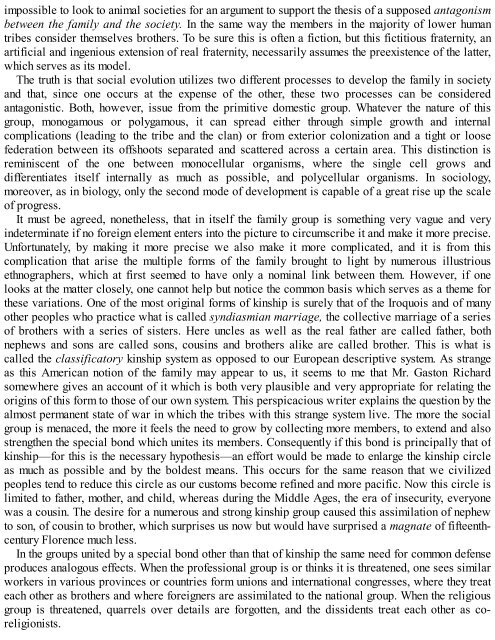3658925934
You also want an ePaper? Increase the reach of your titles
YUMPU automatically turns print PDFs into web optimized ePapers that Google loves.
impossible to look to animal societies for an argument to support the thesis of a supposed antagonism<br />
between the family and the society. In the same way the members in the majority of lower human<br />
tribes consider themselves brothers. To be sure this is often a fiction, but this fictitious fraternity, an<br />
artificial and ingenious extension of real fraternity, necessarily assumes the preexistence of the latter,<br />
which serves as its model.<br />
The truth is that social evolution utilizes two different processes to develop the family in society<br />
and that, since one occurs at the expense of the other, these two processes can be considered<br />
antagonistic. Both, however, issue from the primitive domestic group. Whatever the nature of this<br />
group, monogamous or polygamous, it can spread either through simple growth and internal<br />
complications (leading to the tribe and the clan) or from exterior colonization and a tight or loose<br />
federation between its offshoots separated and scattered across a certain area. This distinction is<br />
reminiscent of the one between monocellular organisms, where the single cell grows and<br />
differentiates itself internally as much as possible, and polycellular organisms. In sociology,<br />
moreover, as in biology, only the second mode of development is capable of a great rise up the scale<br />
of progress.<br />
It must be agreed, nonetheless, that in itself the family group is something very vague and very<br />
indeterminate if no foreign element enters into the picture to circumscribe it and make it more precise.<br />
Unfortunately, by making it more precise we also make it more complicated, and it is from this<br />
complication that arise the multiple forms of the family brought to light by numerous illustrious<br />
ethnographers, which at first seemed to have only a nominal link between them. However, if one<br />
looks at the matter closely, one cannot help but notice the common basis which serves as a theme for<br />
these variations. One of the most original forms of kinship is surely that of the Iroquois and of many<br />
other peoples who practice what is called syndiasmian marriage, the collective marriage of a series<br />
of brothers with a series of sisters. Here uncles as well as the real father are called father, both<br />
nephews and sons are called sons, cousins and brothers alike are called brother. This is what is<br />
called the classificatory kinship system as opposed to our European descriptive system. As strange<br />
as this American notion of the family may appear to us, it seems to me that Mr. Gaston Richard<br />
somewhere gives an account of it which is both very plausible and very appropriate for relating the<br />
origins of this form to those of our own system. This perspicacious writer explains the question by the<br />
almost permanent state of war in which the tribes with this strange system live. The more the social<br />
group is menaced, the more it feels the need to grow by collecting more members, to extend and also<br />
strengthen the special bond which unites its members. Consequently if this bond is principally that of<br />
kinship—for this is the necessary hypothesis—an effort would be made to enlarge the kinship circle<br />
as much as possible and by the boldest means. This occurs for the same reason that we civilized<br />
peoples tend to reduce this circle as our customs become refined and more pacific. Now this circle is<br />
limited to father, mother, and child, whereas during the Middle Ages, the era of insecurity, everyone<br />
was a cousin. The desire for a numerous and strong kinship group caused this assimilation of nephew<br />
to son, of cousin to brother, which surprises us now but would have surprised a magnate of fifteenthcentury<br />
Florence much less.<br />
In the groups united by a special bond other than that of kinship the same need for common defense<br />
produces analogous effects. When the professional group is or thinks it is threatened, one sees similar<br />
workers in various provinces or countries form unions and international congresses, where they treat<br />
each other as brothers and where foreigners are assimilated to the national group. When the religious<br />
group is threatened, quarrels over details are forgotten, and the dissidents treat each other as coreligionists.









![Genki - An Integrated Course in Elementary Japanese II [Second Edition] (2011), WITH PDF BOOKMARKS!](https://img.yumpu.com/58322134/1/180x260/genki-an-integrated-course-in-elementary-japanese-ii-second-edition-2011-with-pdf-bookmarks.jpg?quality=85)
![Genki - An Integrated Course in Elementary Japanese I [Second Edition] (2011), WITH PDF BOOKMARKS!](https://img.yumpu.com/58322120/1/182x260/genki-an-integrated-course-in-elementary-japanese-i-second-edition-2011-with-pdf-bookmarks.jpg?quality=85)





